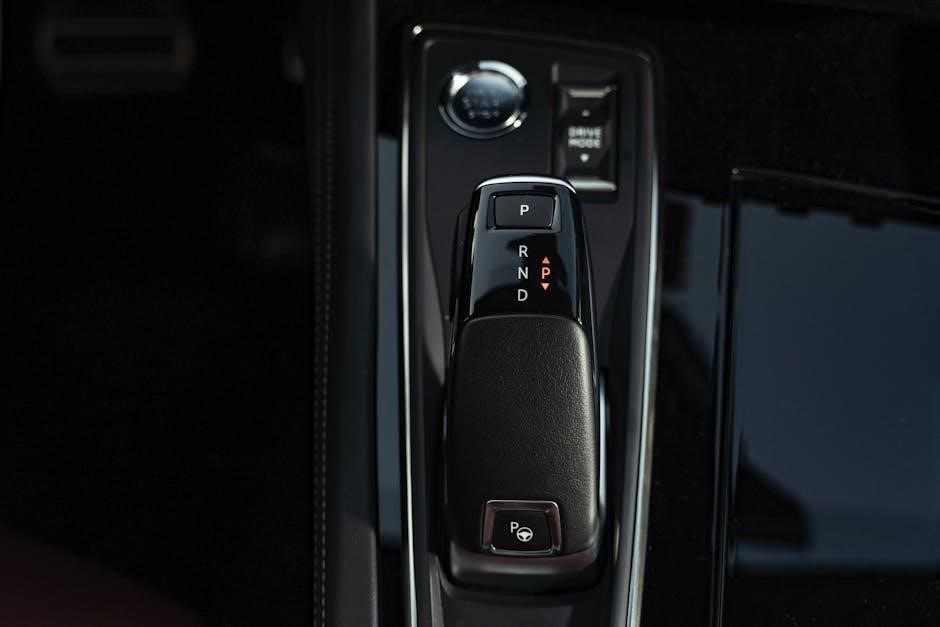The automatic transmission is a critical component of modern vehicles, ensuring smooth gear shifts and optimal power delivery. This guide provides essential insights and practical solutions to identify and address common transmission issues, helping drivers maintain performance and prevent costly repairs. Early detection of problems is key to extending the lifespan of your vehicle’s transmission system.
1.1 Importance of Automatic Transmission Maintenance
Regular maintenance of an automatic transmission is crucial for ensuring smooth operation, optimal performance, and extending its lifespan. Neglecting routine checks can lead to severe issues like fluid leaks, solenoid failures, or torque converter problems, which are costly to repair. By monitoring fluid levels, addressing early symptoms, and performing timely servicing, drivers can prevent major breakdowns, improve fuel efficiency, and maintain consistent vehicle performance. Proper upkeep is essential for avoiding unexpected failures and ensuring reliable transportation.
1.2 Purpose of the Guide
This guide aims to empower vehicle owners with the knowledge to identify and address common automatic transmission issues promptly. By detailing symptoms, causes, and solutions, it simplifies the troubleshooting process, helping drivers avoid costly repairs. The guide emphasizes early detection, DIY checks, and professional interventions, ensuring improved vehicle performance and longevity. Its comprehensive approach enables users to make informed decisions, whether tackling minor fixes or seeking expert assistance, ultimately enhancing their driving experience and car maintenance skills.

Common Symptoms of Automatic Transmission Problems
Recognizing symptoms like slipping gears, unusual noises, fluid leaks, or delayed engagement is crucial for early detection of transmission issues, ensuring timely repairs and preventing further damage.
2.1 Slipping Transmission
A slipping transmission occurs when gears fail to engage properly, causing the vehicle to lose acceleration or decelerate unexpectedly. This can be due to low transmission fluid levels, worn clutch packs, or damaged bands. If left unchecked, it can lead to further damage, such as overheating or gear wear. Identifying the root cause early is essential to prevent costly repairs and ensure safe vehicle operation. Regular maintenance can help mitigate this issue.
2.2 Unusual Noises (Humming, Buzzing, or Whining)
Unusual noises, such as humming, buzzing, or whining, often indicate internal transmission issues. These sounds can be caused by worn bearings, damaged gear teeth, or low transmission fluid levels. The type and pitch of the noise may vary depending on the underlying problem. Addressing these symptoms promptly is crucial, as they can lead to more severe damage if left unchecked. Regular inspections and fluid checks can help identify and resolve these issues early.
2.3 Transmission Fluid Leaks
Transmission fluid leaks are a common issue that can lead to serious problems if not addressed. Leaks often occur due to worn seals, gaskets, or damaged transmission pan gaskets. Signs include fluid spots under the vehicle and low fluid levels. It’s essential to inspect the transmission pan, cooler lines, and seals regularly. Ignoring leaks can cause overheating, slipping, and eventual transmission failure, making prompt repair critical to maintain optimal performance and prevent costly damage. Regular checks can prevent these issues from escalating.
2.4 Vehicle Stuck in Gear or Delayed Engagement
A vehicle stuck in gear or experiencing delayed engagement can disrupt smooth driving and indicate underlying transmission issues. This problem often stems from low transmission fluid levels, obstructed fluid flow, or faulty solenoids. A malfunctioning torque converter can also prevent proper gear engagement. If left unaddressed, it can lead to more severe damage, necessitating costly repairs. Regular maintenance and fluid checks are essential to prevent such issues and ensure optimal transmission performance.
2.5 Burning Smell or Overheating Transmission
A burning smell or overheating transmission is a serious issue that requires immediate attention. This problem often arises from low transmission fluid levels, clogged cooling lines, or excessive friction within the system. Ignoring these symptoms can lead to irreversible damage, such as warped gears or a failed torque converter. Regular fluid checks and maintaining proper cooling system function are critical to preventing overheating and ensuring long-term transmission health. Addressing this issue promptly is essential to avoid costly repairs.
Understanding the Causes of Transmission Issues
Transmission problems often stem from low fluid levels, faulty solenoids, or worn gears; Malfunctioning sensors and torque converter failures also contribute to performance issues, requiring timely inspection and repair.

3.1 Low or Leaking Transmission Fluid
Low or leaking transmission fluid is a frequent cause of automatic transmission issues. Insufficient fluid can lead to overheating, slipping gears, and reduced system performance. Leaks often result from damaged seals, gaskets, or worn-out pan gaskets. Regular fluid level checks and immediate repair of leaks are essential to prevent severe damage and costly repairs. Always use the correct fluid type specified by your vehicle’s manufacturer to ensure optimal performance and longevity.
3.2 Faulty Solenoids or Control Module
Faulty solenoids or a malfunctioning control module are common issues in automatic transmissions. Solenoids regulate fluid flow and pressure, while the control module manages transmission operations. Failed solenoids can cause erratic shifting, slipping, or delayed engagement. A faulty control module may lead to improper gear selection and reduced performance. Diagnosing these issues often involves scanning for OBD codes and testing solenoid resistance. Replacing defective solenoids or reprogramming the control module can resolve these problems and restore smooth transmission operation.
3.3 Torque Converter Failure
Torque converter failure is a significant issue in automatic transmissions, often causing slipping, hesitation, or complete loss of power. The torque converter transmits engine power to the transmission, and its failure can result from worn-out bearings, damaged stators, or debris buildup. Symptoms include a burning smell, fluid leaks, or vibrations. Replacing the torque converter is usually necessary, and it’s crucial to address related issues like fluid contamination to ensure proper transmission function and prevent further damage.
3.4 Worn-Out Gears or Clutch Packs
Worn-out gears or clutch packs are common issues in automatic transmissions, leading to erratic shifting, grinding noises, or failure to engage gears properly. Over time, excessive wear can cause mechanical failure, resulting in complete loss of transmission function. Symptoms often include abnormal shifting patterns, loud noises during gear changes, and vibrations. Early detection is crucial, as ignoring these signs can lead to costly repairs or even total transmission failure, requiring a full rebuild or replacement.
3.5 Malfunctioning Sensors or Wiring
Malfunctioning sensors or wiring can disrupt communication within the transmission system, leading to erratic shifting, delayed engagement, or failure to shift gears. Faulty sensors, such as speed or pressure sensors, can send incorrect signals to the control module, causing abnormal transmission behavior. Damaged wiring can interrupt these signals entirely. Symptoms may include slipping, hesitation, or the transmission staying in a single gear. Addressing sensor or wiring issues promptly is essential to prevent further damage and ensure proper transmission operation.

Diagnostic Steps for Automatic Transmission Problems
Begin by checking transmission fluid level and condition, then scan for OBD codes to identify system faults. Perform a visual inspection for leaks or damage to components.
4.1 Checking Transmission Fluid Level and Condition
Locate the transmission fluid dipstick, typically labeled, and pull it out. Wipe it clean with a lint-free rag. Reinsert, then pull it out again to check the fluid level. Ensure the level is within the recommended range marked on the dipstick. Observe the fluid’s color and consistency; it should be clear and reddish. If dark, dirty, or smelling burnt, it needs changing. Use the correct type of fluid for your vehicle. If low, add fluid slowly, checking frequently to avoid overfilling. Refer to your car’s manual for specific instructions and recommended fluid type.
4.2 Scanning for OBD Codes
Use an OBD-II scanner to retrieve trouble codes from your vehicle’s onboard computer. Transmission-related codes typically fall within the P0700 to P0999 range. Connect the scanner to the OBD-II port, turn the ignition on, and retrieve the codes. Common codes include P0700 (transmission control system malfunction) and P0750 (shift solenoid issues); Record the codes and refer to a repair manual or database for specific definitions. Addressing the root cause of these codes is essential for proper transmission function and to prevent further damage. Always clear codes after repairs to ensure the issue is resolved.
4.3 Visual Inspection for Leaks or Damage
A visual inspection is a crucial step in identifying automatic transmission issues. Check the transmission pan, lines, and cooler for signs of leaks or damage. Look for reddish-brown fluid stains or droplets, which indicate a breach in seals or gaskets. Inspect the pan gasket and line connections for looseness or cracks. Damage to the transmission case or cooler lines can also lead to fluid loss and pressure drops. Addressing these issues early prevents further damage and maintains transmission performance. Regular visual checks are essential for long-term reliability.

Solutions and Repairs for Common Issues
This section provides practical solutions for addressing automatic transmission problems, including fluid replacements, solenoid repairs, and torque converter fixes, ensuring optimal vehicle performance and longevity.
5.1 Replenishing Transmission Fluid
Replenishing transmission fluid is a crucial step in addressing low fluid levels or contamination. Always use the manufacturer-recommended fluid type to ensure compatibility and optimal performance. Check the fluid level using the dipstick, and top it up if necessary. If the fluid is dirty or degraded, a full fluid change is recommended. Regular fluid maintenance helps prevent transmission overheating, slipping, and wear on internal components. It’s essential to address fluid issues promptly to avoid more severe and costly repairs down the road.
5.2 Replacing Faulty Solenoids or Sensors
Faulty solenoids or sensors can disrupt transmission operation, causing slipping, erratic shifting, or delayed engagement. Replacing these components requires identifying the specific issue using diagnostic tools like OBD scanners. Once identified, solenoids or sensors can be replaced by disconnecting electrical connectors, removing faulty parts, and installing new ones. Ensure compatibility by using OEM or high-quality aftermarket replacements. Always consult a repair manual for specific instructions and check wiring for any additional damage to ensure proper transmission function after replacement.
5.3 Repairing or Replacing the Torque Converter

A faulty torque converter can cause slipping, overheating, or failure to engage gears. Repairing it often involves replacing the bearings, seals, or clutch pack. If damaged beyond repair, a replacement is necessary. Ensure the new converter is compatible with your transmission type. Installation requires careful alignment and proper torque specifications. Always drain and refill the transmission fluid after replacement to maintain optimal performance and prevent further issues. Consult a professional if unsure to avoid additional damage to the transmission system.
5.4 Addressing Gear or Clutch Pack Wear
Gear or clutch pack wear can cause slipping, hesitation, or failure to engage gears. Inspect the clutch packs for excessive wear or damage and replace them if necessary. Gears with scoring or pitting should be refinished or replaced. Clean and reassemble the transmission carefully, ensuring proper alignment and torque specifications. Use genuine replacement parts to maintain performance. If wear is severe, consider professional repair to avoid further damage to the transmission system and ensure reliable operation.

Preventative Maintenance Tips
Regular transmission fluid changes, monitoring for leaks, and avoiding extreme driving conditions can prevent major issues. Check fluid levels and condition periodically to ensure optimal performance and longevity.
6.1 Regular Fluid Changes
Regular fluid changes are essential for maintaining the health of your automatic transmission. Over time, transmission fluid degrades, losing its ability to lubricate and cool internal components effectively. Dirty or low fluid levels can lead to increased friction, wear, and potentially catastrophic damage. It is recommended to change the fluid every 30,000 to 60,000 miles, depending on your vehicle’s manufacturer guidelines and driving conditions. Clean fluid ensures smooth gear transitions and prevents overheating, extending the lifespan of your transmission.
6.2 Monitoring Transmission Performance
Monitoring your transmission’s performance is crucial for early detection of potential issues. Pay attention to symptoms like slipping, unusual noises, or fluid leaks, as these can indicate underlying problems. Regularly check the transmission’s behavior during acceleration, shifting, and braking. If you notice erratic shifting, delayed engagement, or a burning smell, address these issues promptly. Monitoring helps prevent minor problems from escalating into major repairs, ensuring your transmission operates smoothly and efficiently over time.
6.3 Avoiding Extreme Driving Conditions
Avoiding extreme driving conditions can significantly prolong the life of your automatic transmission. Extreme heat, cold, or towing heavy loads can strain the system. Frequent stop-and-go traffic, rapid acceleration, or driving in hilly terrains can also cause unnecessary wear. Preventive measures include maintaining a consistent driving style, avoiding overloading, and ensuring proper cooling. Regular checks of the transmission’s cooling system and fluid levels can help mitigate the effects of extreme conditions, ensuring optimal performance and durability.
This guide provides a comprehensive approach to identifying and resolving automatic transmission issues, emphasizing the importance of early detection, regular maintenance, and proper diagnostic techniques to ensure longevity and performance.

7.1 Summary of Key Points
This guide emphasizes the importance of early detection and repair of automatic transmission issues. Common problems include slipping, unusual noises, and fluid leaks, often caused by low fluid levels, faulty solenoids, or worn components. Regular maintenance, such as fluid checks and sensor inspections, can prevent major repairs. Addressing issues promptly ensures optimal performance, avoids costly damage, and extends the lifespan of your vehicle’s transmission system.
7;2 Importance of Early Detection and Repair
Early detection and repair of automatic transmission issues are crucial to prevent minor problems from escalating into costly damages. Ignoring symptoms like slipping or unusual noises can lead to complete system failure, requiring expensive overhauls. Prompt action ensures optimal performance, maintains vehicle reliability, and avoids unexpected breakdowns. Regular checks and addressing issues early safeguard your investment and keep your vehicle running smoothly for years to come.

